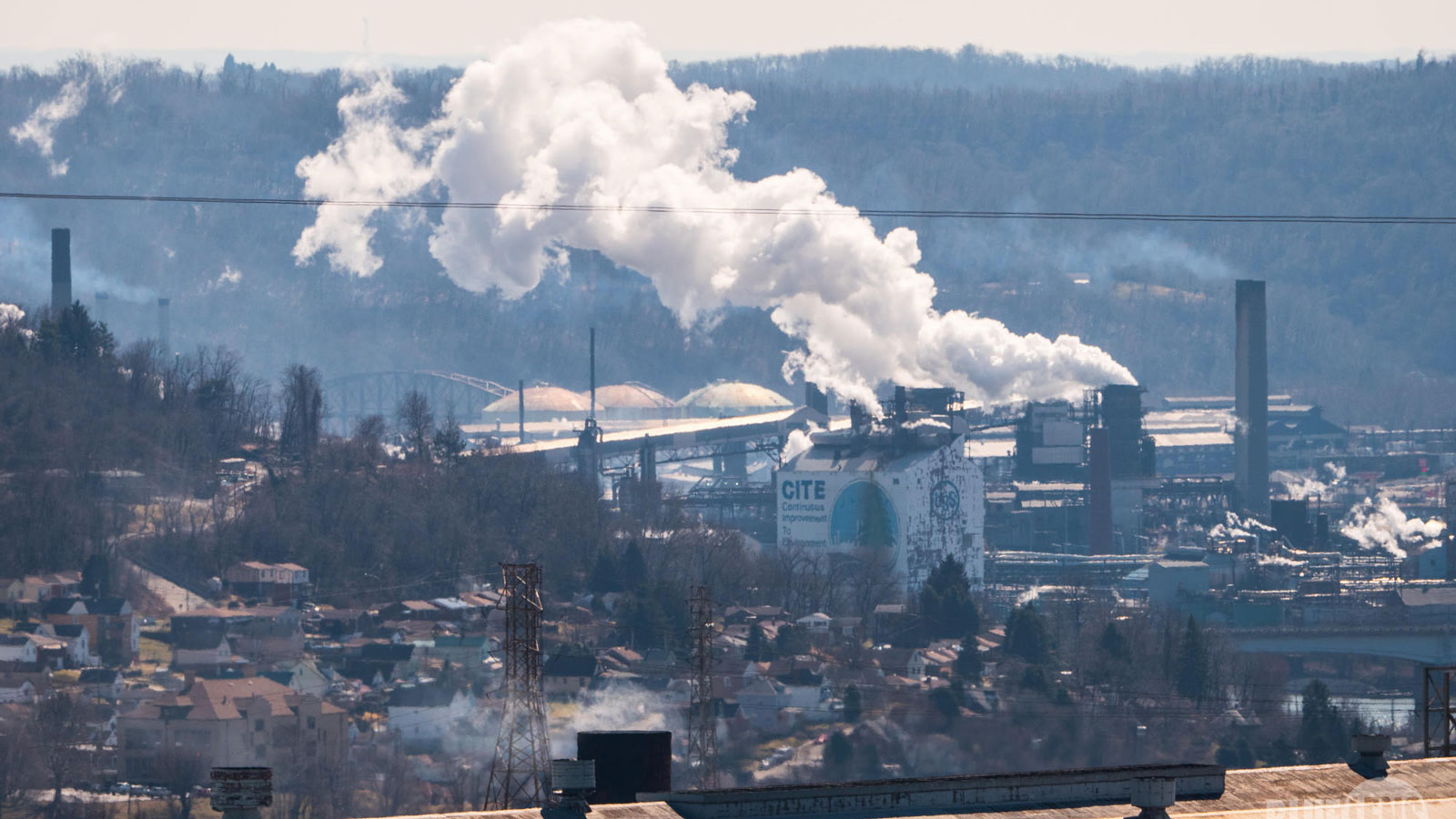
Allegheny County’s Toxic Ten
Ten industrial facilities in Allegheny County emitted a total of more than 1.4 million pounds of toxic air pollution in 2021
Together, ten industrial facilities in Allegheny County emitted a total of more than 1.4 million pounds of toxic pollutants to Allegheny County’s air in 2021 – including substances linked to cancer, birth defects, reproductive problems and other ailments. It’s time for the Allegheny County Health Department (ACHD) to protect the health of Pittsburgh-area residents by taking common sense steps to clean up the county’s most-toxic industrial air polluters – the “Toxic Ten.”
Explore the facts about the 10 facilities emitting the most-toxic air pollution in Allegheny County.
The Pittsburgh area’s air is among the dirtiest in the country
The Pittsburgh area has some of the worst air quality in the nation. In 2022, residents of Allegheny County endured 179 days with elevated levels of ozone “smog” and/or particulate pollution. In 2022, the American Lung Association gave Allegheny County’s air a grade of “F” based on the number of days with excessive levels of ozone and particulates in the county’s air from 2018 through 2020.1
Emissions of toxic air pollutants – pollutants linked to cancer, reproductive or developmental harm, or other serious health effects – also contribute to Allegheny County’s poor air quality. Allegheny County ranked in the top 2% of counties nationwide for added cancer risk from air toxics emissions from stationary sources such as industrial facilities in 2019.
The Toxic Ten emit nearly 80% of toxic industrial air pollution in the county
Facilities in certain industries that use or release toxic chemicals to the environment are required to report those releases to the U.S. EPA’s Toxics Release Inventory (TRI). In 2021, 46 industrial facilities in Allegheny County reported releases of toxic chemicals to air to the TRI. Those reported emissions totaled more than 1.8 million pounds.
Of those 46 facilities, just 10 active facilities – the “Toxic Ten” – were responsible for nearly four-fifths of that pollution, or more than 1.4 million pounds of toxic pollutants released to the air.
Highly toxic pollutants have been linked to serious health effects
Among the pollutants released by the Toxic Ten are toxics linked to serious health effects, including benzene (linked to cancer, developmental and reproductive problems), lead (a powerful neurotoxicant), chromium (a variety of which poses risk of cancer and other health harms), and hydrogen sulfide (which smells of “rotten eggs” and can harm the respiratory and nervous systems).
The “Toxic Ten” facilities highlighted on this website represent those active facilities whose emissions in 2021 posed the greatest toxic hazard, estimated by applying toxicity weighting factors developed for the U.S. EPA’s Risk Screening Environmental Indicators (RSEI) Hazard metric to each facility’s reported toxic releases. (See methodology for more.)

U.S. Steel Clairton coke plant became top toxic polluter in 2021
U.S. Steel’s Clairton coke plant replaced ATI Flat Rolled Products (2019’s leader) as the most-toxic industrial air polluter in Allegheny County in 2021 based on the toxicity of its emissions to the air. The Clairton plant reported releasing more than 1.1 million pounds of toxics to the county’s air in 2021, roughly 60% of all air toxics releases reported by industrial facilities in the county by weight. The facility’s releases accounted for 23% of the toxic hazard posed by industrial air toxics emissions in the county in 2021.
The Cheswick Power Plant (which closed in early 2022), Carpenter Powder Products and Harsco Metals’ Natrona Facility (which did not report toxic air emissions to the EPA in 2021) appeared on the Toxic Ten list for their emissions in 2019 but are not on the 2021 list. (See note in the Methodology below related to Harsco.) TMS International in Braddock, Neville Chemical on Neville Island and the McConway & Torley foundry in Pittsburgh took their place in the Toxic Ten in 2021.
Detailed data
Top 10 most-toxic active industrial facilities in Allegheny County reporting air pollution to TRI in 2021, by facility and hazard-based toxicity result:
1. USS-Clairton Plant
* Blank fields indicate that toxicity weighting information for this chemical is unavailable. See methodology.
2. ATI Flat Rolled Products Holdings LLC
3. Thermal Transfer Corp.
4. PPG Industries Inc. - Springdale Complex
* Blank fields indicate that toxicity weighting information for this chemical is unavailable. See methodology.
5. Universal Stainless & Alloy Products Inc.
6. TMS International LLC
Some releases round to zero.
7. Holtec Manufacturing
Some releases round to zero.
8. Neville Chemical Co.
9. USS Mon Valley Works - Edgar Thomson Plant
10. McConway & Torley LLC
Methodology
The listing of the 10 Allegheny County active industrial facilities with the “most toxic” air emissions in 2021 is based on the facilities’ releases to air of toxic substances as reported to the U.S. EPA’s Toxics Release Inventory (TRI), adjusted to account for the relative toxicity of those releases using hazard weighting factors developed for the EPA’s Risk Screening Environmental Indicators (RSEI) model.
The ranking of Allegheny County’s “Toxic Ten” reflects only those releases reported to TRI. TRI reporting does not capture all releases of hazardous substances from all facilities. Specifically, this analysis under-represents or omits four categories of toxic air releases:
- Releases from facilities that employ fewer than 10 full-time-equivalent employees (and are therefore exempt from TRI reporting).
- Releases from facilities in industries that are not required to report to TRI.
- Releases from facilities in industries covered by TRI that use or release toxic chemicals in quantities that are below the EPA’s TRI reporting thresholds.
- Releases of dangerous or toxic air pollutants for which reporting is not required to TRI, such as fine particulate matter, sulfur oxides, nitrogen oxides and precursors to ozone. These releases are often reported to local and federal authorities through systems other than TRI.
Despite these limitations, TRI remains the most comprehensive source of data available detailing specific toxic releases from industrial facilities to the air.
Toxics Release Inventory
Data from the TRI 2021 National Analysis were downloaded via the Envirofacts TRI Form R & A Download page at https://enviro.epa.gov/facts/tri/form_ra_download.html on 1 November 2022. Only facilities with non-zero values for “air total releases” with locations in Allegheny County were included in this analysis.
Reporting facilities are able to amend their TRI reporting on a continuous basis. The National Analysis data used in this analysis was “frozen” in October 2022 and does not include revisions made by facilities after that date. As a result, the figures cited in this analysis may not match data currently available on some pages of the EPA web site.
The industry categories used in this analysis were obtained by matching the North American Industry Classification System (NAICS) codes available in the TRI data download with 2017 NAICS code definitions from the U.S. Census Bureau, downloaded 16 May 2022 from https://www.census.gov/naics/?48967.
Calculating Hazard-based results
The EPA’s Risk Screening Environmental Indicators (RSEI) provide toxicity-weighted measures with which to assess the level of potential hazard or risk to public health posed by chemical releases reported under the TRI. In this analysis, we used toxicity weights used to produce the EPA’s “RSEI Hazard” metric to compare the toxicity of air releases from facilities in Allegheny County. The RSEI Hazard metric provides a screening-level indicator useful for comparing releases but does not account for potential routes of human exposure to toxics released by industrial facilities.
EPA had not yet released RSEI Hazard data for the 2021 TRI reporting year as of the date of this analysis. We calculated Hazard-based results for each facility, following EPA methodologies and using the EPA’s RSEI Toxicity Weighting Spreadsheet v.2.3.10, downloaded from https://www.epa.gov/rsei/rsei-documentation-and-help, 1 November 2022. In most cases, Hazard-based results were calculated by multiplying the facility’s release of a particular chemical in pounds by the inhalation toxicity weight (ITW) of that chemical.
In two cases, calculation of the Hazard-based result required an additional step:
- Dioxin and dioxin compounds – Different forms of dioxin vary in their toxicity. To account for this, EPA requires facilities reporting releases of dioxin and dioxin compounds to report separately the releases of 17 individual dioxin congeners. This detailed reporting is then used by the EPA to calculate a facility-specific toxic equivalency (TEQ), which represents the quantity of the most-toxic member of the dioxin class that would need to be released to have a similar toxic effect to the specific mix of dioxin congeners released by that facility. For this analysis, we obtained TEQs for the two facilities in Allegheny County with reported air releases of dioxin (Cheswick Power Plant in Springdale and Calgon Carbon Corp.’s Neville Island plant) and replaced the reported dioxin releases from those facilities (reported in grams) with the TEQ value.2 We then multiplied the TEQ by the ITW for dioxin and dioxin compounds in the EPA’s RSEI Toxicity Weighting Spreadsheet to arrive at the Hazard-based toxicity value.
- Chromium and chromium compounds – Facilities that emit chromium typically emit a combination of two types, or valences, of the element: chromium (III), also called trivalent chromium, and chromium (VI), also called hexavalent chromium. Facilities reporting to TRI, however, report under the umbrella category, “chromium and chromium compounds,” which includes releases of both valences. Trivalent chromium has “a very low toxicity,” according to the EPA’s RSEI model methodology documentation, and therefore is assumed to have no toxicity in the RSEI model.3 EPA bases each facility’s ratio of trivalent to hexavalent chromium emitted on industry-specific factors from the 2017 National Emissions Inventory (NEI). 4
To calculate the Hazard-based result for each facility, we multiplied the reported air releases of chromium and chromium compounds (in pounds) by the percentage of each facility’s releases made up of chromium (VI). Each facility’s chromium VI percentage was derived from industry-specific factors obtained in the U.S. EPA’s TRI-based Chromium Speciation Excel spreadsheet, downloaded from https://gaftp.epa.gov/air/nei/2017/doc/supporting_data/TRI_based_chromium_speciation.zip , 7November 2022. Each facility’s primary NAICS code was used to identify the appropriate chromium speciation profile for each facility. The percentage of chromium VI in that profile was then multiplied by the facility’s reported releases of chromium and chromium compounds to obtain an adjusted release figure, which could then by multiplied by the appropriate RSEI toxicity weight. Facilities without an industry-specific profile were assigned the default value of 34% chromium VI, as described in the EPA’s RSEI Methodology.5
EPA’s RSEI Toxicity Weighting Spreadsheet does not include a weighting factor for every chemical with releases reported under the TRI. Consistent with EPA methodology, those releases are not assigned a RSEI Hazard value and do not count toward a facility’s ranking.6
Identifying chemical health effects
Each toxic substance reported as released by a facility was evaluated to determine if it was associated with cancer, developmental harm or reproductive toxicity. The assessment of the health effects of the substances is based on analysis conducted for the Environment America Research & Policy Center report, Wasting Our Waterways, published in September 2022, updated to include substances released to air by Allegheny County polluters that were not included in that report. 7
The information used to assign health effects to toxic releases was primarily obtained from two datasets. The first was the EPA’s TRI Toxics Tracker tool at https://edap.epa.gov/public/extensions/ TRIToxicsTracker/TRIToxicsTracker.html, downloaded on 10 May 2022. We used the “Potential Health Effects” option under the “Chemicals” tab and selected all reporting years in the filter options. The other dataset was California’s Proposition 65 list of known harmful chemicals and their effects, downloaded on 9 May 2022 at https://oehha.ca.gov/proposition-65/proposition-65-list (and reviewed for updates on 21 February 2023) Health effects for chemicals indicated in the “Prop 65” list as having been “delisted” or for which a given health effect was “removed” were excluded from the dataset. The following rules were followed in assigning health effects to toxic substances:
- Chemicals listed as known to cause cancer, reproductive or developmental toxicity in the Prop 65 list were assigned those health effects.
- Toxic substances that were not listed as tied to a given health effect on the Prop 65 list, but that were tied to that effect on the EPA list, were evaluated further using the EPA’s CompTox Chemicals Dashboard, which aggregates chemical warnings and toxicity determinations by authorities in the United States, Europe, Japan, Australia and other jurisdictions across the globe.8 Chemicals included on the EPA Toxics Tracker for a health effect that at least one other authority found “may cause” that health effect were included in the list used in this report. Substances listed by authorities as “suspected” of causing a health effect were not included.
- Releases of certain chemicals are reported to the EPA by class, instead of, or in addition to, reported releases of the individual substance, thus requiring a determination of whether the class of chemicals is linked to a particular health effect. Because different compounds within a class may have differing levels and forms of toxicity, because there is no way to distinguish among which compounds in a class are being released, and because the EPA and Prop 65 lists are sometimes unclear as to which health effects are associated with particular chemicals, we applied the following rules in assigning health effects to chemicals and related chemical classes:
- If, in the Prop 65 list or other sources, health effects were associated with a substance and its compounds, those health effects were assumed to be associated with releases of the substance and its compounds as reported to TRI.
- If health effects in the Prop 65 list or other sources were associated with either a type of compounds as a class, or specific compounds of an element (usually a metal), but not specifically with the elemental form of the substance, those health effects were assumed to be associated with the “[ELEMENT] and [ELEMENT] Compounds” category in TRI if the substance and its compounds had the same toxicity weight in RSEI.
- Reported releases of “Chromium and chromium compounds” (TRI class N090) were associated with cancer, developmental harm and reproductive health effects of hexavalent chromium compounds as indicated on the Prop 65 list. Reported releases of “Chromium” (Chemical Abstracts Service number 7440-47-3) were not assigned the health effects of chromium compounds.
In some cases, groups of chemicals or individual chemicals were listed with associated health effects in the Prop 65 list but with no corresponding Chemical Abstracts Service (CAS) number. In these cases, CAS numbers were obtained from the EPA’s listing of TRI chemicals or obtained from other sources and assigned as described in the footnote.9
Inactive facilities
The Cheswick power plant ranked eighth for toxicity of its air releases in 2021. However, the facility closed in the spring of 2022 and was therefore excluded from the Toxic Ten list. McConway & Torley, which had ranked 11th for toxic air releases in 2021, was then included in the Toxic Ten.
Harsco Metals
Harsco Metals in Natrona Heights has appeared in all previous editions of the Toxic Ten, ranking second for the toxicity of its releases to Allegheny County’s air in 2019. The facility, which processes steel slag from the neighboring ATI Flat Rolled Products plant, released compounds of chromium, lead, manganese and nickel to the region’s air in 2019 and 2020, but as of the time of publication of this website, had not reported toxic releases for 2021 to the EPA’s Toxics Release Inventory. It is unknown whether Harsco is no longer required to report to TRI (for example, by reducing its use or releases of toxic substances below reporting thresholds) or has simply failed to report. The company’s 2020 releases would have ranked it among the Toxic Ten in this report.
Population, schools and hospitals within three-mile radius
The population within three miles of each facility was obtained from the U.S. EPA, which calculates this figure for each facility in its Enforcement and Compliance History Online (ECHO) database.
The number of schools and hospitals within three miles of each facility was determined via GIS analysis. A shapefile with the locations of hospitals in the commonwealth was obtained from the Pennsylvania Department of Health via Pennsylvania Spatial Data Access on 29 December 2022. A listing of public and public charter schools in Allegheny County was obtained from the Pennsylvania Department of Education, Educational Names & Addresses (EdNA) database on 29 December 2022. The addresses from the EdNA database were geocoded using the U.S. Census Bureau’s public batch geocoding tool, with schools that did not produce matches then manually geocoded using Google Maps searches. Parochial and private schools are not included in the number of schools reported for each facility.
Acknowledgements
The authors are grateful to John Graham, senior scientist at Clean Air Task Force for his review and suggestions, and to the Heinz Endowments for making this project possible.
Notes
- Defined as days on which the EPA’s Air Quality Index for either pollutant exceeded 50, a level the EPA defines as “moderate,” but has been associated with threats to public health. For more information on the health effects of air pollution, please see PennEnvironment Research & Policy Center and Frontier Group, Trouble in the Air, October 2021.
- TEQs for stack or point air emissions (Section 5.2 of TRI Form R) were used. The TEQ for Cheswick was obtained from U.S. EPA, Envirofacts, Form R Reports: Cheswick Power Plant, accessed at https://enviro.epa.gov/enviro/tri_formr_partone_v2.get_details?rpt_year=2021&fac_id=15024CHSWCPITTS&ban_flag=Y, 3 November 2022; the TEQ for Calgon Carbon was obtained from U.S. EPA, Envirofacts, Form R Reports: Calgon Carbon Corp. Neville Island Plant, accessed at https://enviro.epa.gov/enviro/tri_formr_partone_v2.get_details?rpt_year=2021&fac_id=15225CLGNC200NE&ban_flag=Y, 3 November 2022.
- U.S. Environmental Protection Agency, EPA’s Risk-Screening Environmental Indicators (RSEI) Methodology, RSEI Version 2.3.10, May 2022, archived at https://web.archive.org/web/20221122185535/https://www.epa.gov/system/files/documents/2022-06/RSEI%20Methodology%20V2.3.10.pdf, p. 18.
- U.S. Environmental Protection Agency, EPA’s Risk-Screening Environmental Indicators (RSEI) Methodology, RSEI Version 2.3.10, May 2022, archived at https://web.archive.org/web/20221122185535/https://www.epa.gov/system/files/documents/2022-06/RSEI%20Methodology%20V2.3.10.pdf, p. 18.
- U.S. Environmental Protection Agency, EPA’s Risk-Screening Environmental Indicators (RSEI) Methodology, RSEI Version 2.3.10, May 2022, archived at https://web.archive.org/web/20221122185535/https://www.epa.gov/system/files/documents/2022-06/RSEI%20Methodology%20V2.3.10.pdf, p. 18 at note 18.
- U.S. Environmental Protection Agency, EPA’s Risk-Screening Environmental Indicators (RSEI) Methodology, RSEI Version 2.3.10, May 2022, archived at https://web.archive.org/web/20221122185535/https://www.epa.gov/system/files/documents/2022-06/RSEI%20Methodology%20V2.3.10.pdf, p. 12.
- Bryn Huxley-Reicher, et al., Environment America Research & Policy Center, U.S. PIRG Education Fund and Frontier Group, Wasting Our Waterways: Toxic pollution and the unfulfilled promise of the Clean Water Act, September 2022, available at https://environmentamerica.org/center/resources/wasting-our-waterways/. The following chemicals that were not included in Wasting Our Waterways were evaluated for their health effects using the same methodology as described in this section, using the same sources: hydrochloric acid, 2,4-dinitrotoluene, sulfuric acid, 2,6-dinitrotoluene, aluminum. In addition, we reviewed the California Proposition 65 list for any changes since publication of Wasting Our Waterways.
- U.S. Environmental Protection Agency, CompTox Dashboard, available at https://comptox.epa.gov/dashboard/.
- Bis(2-chloro-1-methylethyl)ether, technical grade” assigned CAS number 108-60-1 as found 31 May 2022 at https:// iris.epa.gov/ChemicalLanding/&substance_nmbr=407#:~:text=Bis(2%2Dchloro%2D1,%7CIRIS%7CUS%20EPA%2C%20 ORD; “3,3’-Dimethoxybenzidine-based dyes metabolized to 3,3’-dimethoxybenzidine” assigned CAS number 119-90-4 as found 31 May 2022 at https://pubchem.ncbi.nlm.nih.gov/compound/3_3_-Dimethoxybenzidine#section=Other-Identifiers; “3,3’-Dimethylbenzidine-based dyes metabolized to 3,3’-dimethylbenzidine” assigned CAS number 119-93-7 as found 31 May 2022 at https://cameochemicals.noaa.gov/chemical/16097; “Dinitrotoluene (technical grade)” and “Dinitrotoluene mixture, 2,4-/2,6-” assigned CAS number 25321-14-6 as found 31 May 2022 at https://cameochemicals.noaa.gov/chemical/612; “Lindane and other hexachlorocyclohexane isomers” assigned CAS number 58-89-9 as found by searching TRI release data for lindane; “Pentachlorophenol and by-products of its synthesis (complex mixture)” assigned CAS number 87-86-5 as found by searching TRI release data for pentachlorophenol; “Perfluorononanoic acid (PFNA) and its salts” assigned CAS number 375-95-1 as found by searching TRI release data for perfluorononanoic acid; “Perfluorooctane sulfonic acid (PFOS) and its salts and transformation and degradation precursors” assigned CAS number 1763-23-1 as found by searching TRI release data for perfluorooctane sulfonic acid; “Polychlorinated biphenyls” and “Polychlorinated biphenyls (containing 60 or more percent chlorine by molecular weight)“ assigned CAS number 1336-36-3 as found by searching TRI release data for polychlorinated biphenyls; “Quinoline and its strong acid salts” assigned CAS number 91-22-5 as found by searching TRI release data for quinoline.
Topics
Authors
David Masur
Executive Director, PennEnvironment Research & Policy Center
As executive director, David spearheads the issue advocacy, civic engagement campaigns, and long-term organizational building for PennEnvironment. He also oversees PennPIRG and other organizations within The Public Interest Network that are engaged in social change across Pennsylvania. David’s areas of expertise include fracking, global warming, environmental enforcement and litigation, and clean energy and land use policy in Pennsylvania. David has served on the environmental transition teams for Gov. Tom Wolf and Philadelphia Mayor Jim Kenney, and been named one of Pennsylvania’s “40 under 40” environmentalists by the Pennsylvania Environmental Council. Under David’s leadership, PennEnvironment has won the two largest citizen suit penalties in Pennsylvania history against illegal polluters under the federal Clean Water Act. David lives in South Philadelphia with his family, where they’re involved in their local elementary school, community garden and civic association.
Zach Barber
Clean Air Advocate, PennEnvironment Research & Policy Center
Zachary leads PennEnvironment’s Clean Air for Pittsburgh campaign, working with community leaders, public officials and coalition partners to curb Pittsburgh’s air pollution. Zachary has run a canvass office registering thousands of underrepresented voters, helped Pittsburghers have their voices heard on climate, and organized a statewide citizen advocacy day. Zachary lives in Pittsburgh, where he enjoys reading sci-fi novels and watching the Pittsburgh Penguins.
Tony Dutzik
Associate Director and Senior Policy Analyst, Frontier Group
Tony Dutzik is associate director and senior policy analyst with Frontier Group. His research and ideas on climate, energy and transportation policy have helped shape public policy debates across the U.S., and have earned coverage in media outlets from the New York Times to National Public Radio. A former journalist, Tony lives and works in Boston.
Find Out More

Gas-Powered Leaf Blower Laws in Pennsylvania
PennEnvironment and Clean Air Council V. US Steel Motion for Entry and Proposed Consent Decree
Coalition Letter in support of PA Appliance Efficiency Standards 2023-2024














